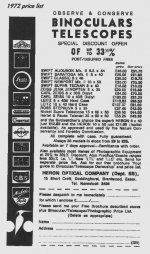I saw an ad from 1947 with Wollensack 8x30s for $72.50.
These days, this would be $735. Having just cleaned some up,
I would say you could buy something better now for $65 (today money).
..like Nikon Acculon 211 7x35s.
For the same performance? Maybe 30$ (Bushnell Falcons now, a better view but less rugged).
So that's a huge improvement in bang-per-buck.
At a much higher quality level, a pair of Sans&Streiffe 8x30 wides
in 1950 at $150 would be $1429 now.
It would take about $150 in a porro to match that now.
So it seems that productivity in binoculars has erased inflation, practically.
At the highest prices, probably not as much. Lower quantities make
economies of scale harder to attain.
It boggles the mind, buying so-so binoculars for $735.
The grunt's binoculars in WW2 probably costed more than the guns.
These days, this would be $735. Having just cleaned some up,
I would say you could buy something better now for $65 (today money).
..like Nikon Acculon 211 7x35s.
For the same performance? Maybe 30$ (Bushnell Falcons now, a better view but less rugged).
So that's a huge improvement in bang-per-buck.
At a much higher quality level, a pair of Sans&Streiffe 8x30 wides
in 1950 at $150 would be $1429 now.
It would take about $150 in a porro to match that now.
So it seems that productivity in binoculars has erased inflation, practically.
At the highest prices, probably not as much. Lower quantities make
economies of scale harder to attain.
It boggles the mind, buying so-so binoculars for $735.
The grunt's binoculars in WW2 probably costed more than the guns.




